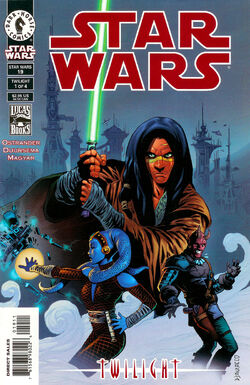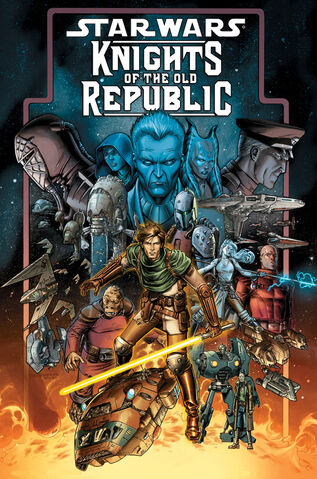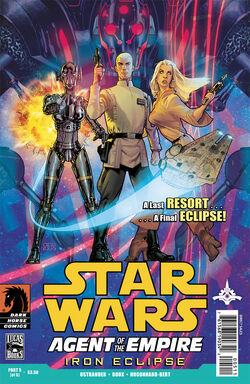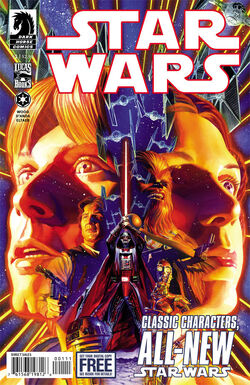
Among the many Star Wars licensees, Dark Horse has been the nearest to untouchable over the last decade or so. Among loud discontent with the direction of the novels, the merits of the TV show, and the decline of the video games, there has been little complaint about the quality of the comics. But hidden in that strong output has been one serious long-term mistake that has significantly undermined the quality, potential, and lifespan of Dark Horse’s recent product. That mistake is the abandonment of ongoing monthly series in favor of series of miniseries.
Since roughly 2000, when Quinlan Vos stepped into the pages of Republic (then still known simply as Star Wars), the comics side of Star Wars has been noted for consistently high-quality output. Republic, Empire, Tales, Legacy, Knights of the Old Republic — all were excellent, beloved series with good sales. All those series, with the exception of Tales, which came out every third month with extra-long issues, were structured as monthly ongoing series.
2006 featured the first deviation from that pattern. Legacy and Knights of the Old Republic were launched as ongoings, and Republic and Empire changed names to Dark Times and Rebellion, respectively, but more significantly changed release schedules to run in alternating five-issue arcs. Instead of having an issue of each series on the stands each month, one series would release issues until it completed an arc, then the next series would run. That planned release schedule was quickly run off the rails by the long delays for Dark Times, associated with Doug Wheatley’s art (which is, at least, worth waiting for). Rebellion lost synch with Dark Times, but continued to run only in five-issue arcs with longer stretches in which it disappeared from stands entirely. This was the first intrusion of the miniseries model into Dark Horse’s offerings.

It was not until several years later that Dark Horse moved entirely over to the new model, in which it ran no monthly ongoings. Instead, everything was done in miniseries. Series like Invasion, Dark Times, Blood Ties, Agent of the Empire, Knight Errant, and Dawn of the Jedi ran five-issue arcs released as miniseries, disappeared, and then came back months later with another arc. Combined with the release of multiple one-off miniseries — Jedi, Knights of the Old Republic: War, Legacy: War, Lost Tribe of the Sith, Crimson Empire III, the multiple Darth Vader miniseries — the Star Wars comics landscape became a confusing welter of titles that appeared and disappeared from stands with little fanfare, consistency, or predictability for those not closely following announced release schedules.
To be honest, I don’t know why Dark Horse moved over to the miniseries model, in which even notionally ongoing series like Knight Errant and Invasion became a series of miniseries. It does offer the advantage of allowing for one artist to remain on the title for all the issues, as artists simply can’t put out twelve issues a year. It also allows Dark Horse to offer more titles “at once” in a larger sense. But those are only limited upsides, whereas the downside should be obvious: titles become unpredictable and hard to follow, follow-up is delayed, and in an industry that relies on keeping readers constantly engaged and buying the next installment, it undermines exactly the sort of connection with the reader that a series needs. Sure, everything had a new number one issue, but the power of that number to attract some new readers pales next to the importance of keeping readers invested.

When Legacy or Knights of the Old Republic was coming out every month, the ongoing story was eagerly followed by online posters at the Jedi Council Forums. Dawn of the Jedi and Knight Errant, from the same beloved creators, simply haven’t gotten the same response, and not for lack of ongoing story. Sales reflect the same story: in February 2012, the first issue of Dawn of the Jedi (and first issues typically sell the most) sold nearly nineteen thousand issues and subsequent issues have averaged around sixteen thousand, whereas any given issue of Legacy tended to sell nearly thirty thousand issues. Knight Errant likewise sits at least ten thousand issues lower than Knights of the Old Republic averaged. The difference is not a function of the recession lowering comic sales in general; 2012 comic sales are actually slightly stronger than they were in 2008, and the Star Wars titles have slipped not just in overall sales, but in their sales rank relative to other titles. Dawn of the Jedi debuted as the one hundred sixth highest-selling title; a random February 2008 Legacy issue, for example, stood at sixty-first. The fact that Star Wars sales have nearly halved appears to be a completely independent issue.
It is hard not to draw the connection between slumping sales and a sales model that made it hard to follow titles, did not put them out consistently for the buyer to keep purchasing, and limited the urgency to follow along with the story when it disappeared from stands, and thus minds, for long stretches. I think it is indisputable that the miniseries model did terrible damage to readers’ ability to invest in the miniseries titles. Whatever motives Dark Horse had when it tried out the new model, I think it is time that we conclusively dismissed it as a badly failed experiment.

It is good to see Dark Horse finally moving back to monthlies with Brian Wood’s Star Wars and Legacy Volume Two. But the experiment with miniseries is not entirely over yet, and the misguided format has still cost us excellent series like Agent of the Empire (canceled due to low sales that cannot have been helped by the release format) and undermined series like Rebellion, Knight Errant, and Invasion that have stopped running mid-story for one reason or another while failing to get out as many issues as they could had they been monthlies.
I liked having so many different titles, so many different directions, available when the miniseries model was in full swing, but in the long run, it seems better if Dark Horse concentrates on a few monthlies that can run strong and long rather than attempt a scattershot schedule of a great many titles that prevents any of the titles from gaining purchase and leads to the failure and abandonment of series mid-run.
(For those of you interested in the source for the sales figures I cited, I was using comics guru John Jackson Miller’s excellent Comichron database. Feel free to explore it for yourself; I’d love to see any further insights you glean from the data.)

When DHC moved completely to the miniseries-only model, I saw it as a reflection of the success of the Mignolaverse model but feared that model was being mis-applied to SW. So it has proven, the two series just aren’t the same!
I’ve always assumed that miniseries were a reflection of DH being a smaller publisher–not so much that sales weren’t good for KOTOR and Legacy, but that they weren’t good enough to run 12 issues per year in perpetuity. In theory, selling 20 thousand copies of something five times a year could still produce higher profit margins than selling 30 thousand copies of something twelve times a year–and where a behemoth like Marvel can absorb the occasional dip, and maybe even make up the difference via Digital and trades, DH’s head may not have been quite so high above water. Just speculation, of course; it really is interesting how silent they’ve remained on this topic over the years.
Well, looking at the math, in June 2012, DH sold about 70,000 copies running four titles. That’s 17,500 issues sold per creative team they’re paying. In June 2007, they sold about 55,000 copies of two series — 27,500 per creative team. And KOTOR happened to be off that month. Go to June 2008, and four titles happened to be running, selling 95,000 or so. When four better-established ongoing series were running, they sold 23,750 issues per creative team. It looks to me like they were clearly getting better margins off established ongoings than the mess of miniseries — more returns per investment in talent and titles to promote.
It helped that the 4 ongoings, such as they were, were a success.
In that respect I can see the thinking for the mini-series approach, it allows for a wider line of product without being restricted to just 3-4. I suppose you could have 1 wide-ranging title, not limited to any era or cast but that’s kind of what Star Wars Tales did and that ended.
Part of the problem is that DHC is a small company relative to the behemoths of Marvel and DC, they punch way above their weight! But it means they can only really do 3-4 SW titles. On this basis, I can see why they went for a miniseries model. Plus thinking would be more multi-era in the wake of ROTS isn’t that outlandish a line of thought.
The other part is the Direct Market and how it operates, it favours known quantities and products. Some shops operate pull list systems 2 months ahead. A title that regularly changes may not be a success because the consumer wants to know what they’ll be getting without having paid attention to the solicits! In this respect the blizzard of #1 issues and what leads where proved murder for my then local shop to navigate. In contrast Legacy and KOTOR – easy!
I’ve said this same thing from the beginning. One of the things that killed Knight Errant and Invasion for me personally, if not for everyone, is the fact that it always took me two or three issues into the new arc to get back in to the story. Sure, I could have reread the previous arc, but I don’t have infinite time on my hands and preferred to use the hour or so it would have taken me to read something that I hadn’t read before.
The other downside of the miniseries format, which you didn’t touch on, is the fact that it forces all stories into five-issue arcs. Some of my favorite Legacy and Knights of the Old Republic stories were one-shots (Like KotOR’s Faithful Execution) or short arcs (Legacy’s Indomitable). On the miniseries plan, the former tale probably wouldn’t have been told at all while the latter would either have been extended into a full arc (bloating the story and preventing us from seeing Cade and co. for a year) or taking up page-space in a Cade arc when the focus should be firmly on the series’ main protagonist.
The point about standardizing arc sizes is a good one and one that’s bugged me in the past. I really miss the flexibility and variety of one-shots and two-, three-, four-, and six-part arcs.